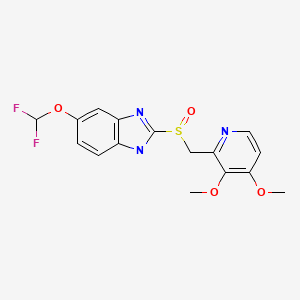Attribution Statement: LactMed is a registered trademark of the U.S. Department of Health and Human Services.
NCBI Bookshelf. A service of the National Library of Medicine, National Institutes of Health.
Drugs and Lactation Database (LactMed®) [Internet]. Bethesda (MD): National Institute of Child Health and Human Development; 2006-.
CASRN: 102625-70-7

Drug Levels and Effects
Summary of Use during Lactation
Maternal pantoprazole doses of 40 mg daily produce low levels in milk and would not be expected to cause any adverse effects in breastfed infants.
Drug Levels
Maternal Levels. A mother who was 10 months postpartum and partially nursing her infant was given a single 40 mg dose of oral pantoprazole. Pantoprazole was detectable in milk only 2 and 4 hours after the dose with milk levels of 36 mcg/L and 24 mcg/L, respectively, at those times. It was not detectable (<10 mcg/L) in milk at 6, 8 and 24 hours after the dose. The authors estimated that a fully breastfed infant would receive 0.14% of the maternal weight-adjusted dosage.[1]
Twelve lactating women were given oral pantoprazole 40 mg daily for one week. Maternal blood and breastmilk samples were obtained 7 times over the 12 hours following the dose on both days. The mean pantoprazole concentration in breastmilk was 62 mcg/L on day 1 and 153 mcg/L on day 7. Overall, 21 of 97 breastmilk samples contained detectable (>30 mcg/L) pantoprazole. On day 1, 21% of milk samples contained measurable pantoprazole and on day 7, 22% contained measurable pantoprazole.[2] Further description of the time course was not contained in the abstract.
Infant Levels. Relevant published information was not found as of the revision date.
Effects in Breastfed Infants
Relevant published information was not found as of the revision date.
Effects on Lactation and Breastmilk
A retrospective claims database study in the United States found that users of proton pump inhibitors had an increased risk of gynecomastia.[3]
A review article reported that a search of database from the European Pharmacovigilance Centre found 48 cases of gynecomastia, 3 cases of galactorrhea, 14 cases of breast pain and 4 cases of breast enlargement associated with pantoprazole. A search of the WHO global pharmacovigilance database found 97 cases of gynecomastia, 13 cases of galactorrhea, 35 cases of breast pain and 16 cases of breast enlargement associated with pantoprazole.[4]
Alternate Drugs to Consider
References
- 1.
- Plante L, Ferron GM, Unruh M, et al. Excretion of pantoprazole in human breast. J Reprod Med. 2004;49:825–7. [PubMed: 15568407]
- 2.
- Bor S, Karacaoglu S, Ergun P, et al. The levels of pantoprazole in human breast milk and plasma: Two compartment model. Neurogastroenterol Motil 2017;29:79-80. Abstract. doi: 10.1111/nmo.13180. [CrossRef]
- 3.
- He B, Carleton B, Etminan M. Risk of gynecomastia with users of proton pump inhibitors. Pharmacotherapy. 2019;39:614–8. [PubMed: 30865318]
- 4.
- Ashfaq M, Haroon MZ, Alkahraman YM. Proton pump inhibitors therapy and risk of hyperprolactinemia with associated sexual disorders. Endocr Regul. 2022;56:134–47. [PubMed: 35489049]
Substance Identification
Substance Name
Pantoprazole
CAS Registry Number
102625-70-7
Drug Class
Breast Feeding
Milk, Human
Anti-Ulcer Agents
Gastrointestinal Agents
Proton Pump Inhibitors
Disclaimer: Information presented in this database is not meant as a substitute for professional judgment. You should consult your healthcare provider for breastfeeding advice related to your particular situation. The U.S. government does not warrant or assume any liability or responsibility for the accuracy or completeness of the information on this Site.
- User and Medical Advice Disclaimer
- Drugs and Lactation Database (LactMed) - Record Format
- LactMed - Database Creation and Peer Review Process
- Fact Sheet. Drugs and Lactation Database (LactMed)
- Drugs and Lactation Database (LactMed) - Glossary
- LactMed Selected References
- Drugs and Lactation Database (LactMed) - About Dietary Supplements
- Breastfeeding Links
- PubChem SubstanceRelated PubChem Substances
- PubMedLinks to PubMed
- Structural identification and characterization of potential impurities of pantoprazole sodium.[J Pharm Biomed Anal. 2007]Structural identification and characterization of potential impurities of pantoprazole sodium.Reddy GM, Bhaskar BV, Reddy PP, Ashok S, Sudhakar P, Babu JM, Vyas K, Mukkanti K. J Pharm Biomed Anal. 2007 Oct 18; 45(2):201-10. Epub 2007 Jun 2.
- Review Esomeprazole.[Drugs and Lactation Database (...]Review Esomeprazole.. Drugs and Lactation Database (LactMed®). 2006
- Review Omeprazole.[Drugs and Lactation Database (...]Review Omeprazole.. Drugs and Lactation Database (LactMed®). 2006
- Review Lansoprazole.[Drugs and Lactation Database (...]Review Lansoprazole.. Drugs and Lactation Database (LactMed®). 2006
- Review Verapamil.[Drugs and Lactation Database (...]Review Verapamil.. Drugs and Lactation Database (LactMed®). 2006
- Pantoprazole - Drugs and Lactation Database (LactMed®)Pantoprazole - Drugs and Lactation Database (LactMed®)
Your browsing activity is empty.
Activity recording is turned off.
See more...
